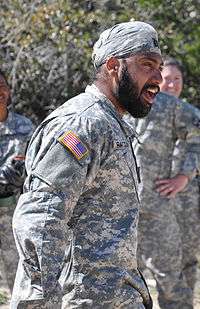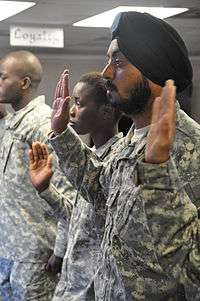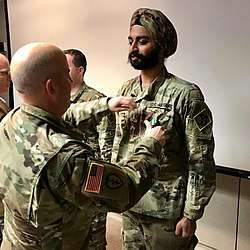Sikhs in the United States military
There have been Sikhs in the United States military since World War I. Sikhs have served through all subsequent wars until the present day. Since the 1980s, observant Sikhs have faced difficulty in serving due to a discontinuation of exemptions to uniform standards which previously allowed Sikhs to maintain their religiously-mandated beards and turbans while in uniform.

World War I and World War II

One of the earliest Sikh soldiers in the American military was Bhagat Singh Thind, who although not a U.S. citizen enlisted in the United States Army and served in World War I. Bhagat Singh Thind was the first Sikh in US military service to be granted the right to wear a turban while on active duty in the US Army. Thind requested citizenship at the end of the war, but was refused. He was granted citizenship in 1936.[1] Sikh participation as a part of U.S. forces in World War I was limited due to their small population in the country, but 138,000 Sikhs served in other Allied forces. Large numbers of Sikhs served in U.S. forces during World War II, and all American wars following.
During World War II Sikh units of the Indian and Commonwealth forces served under Allied command alongside or in cooperation with American forces and earned a reputation for bravery, serving notably against the Germans and Italians in East Africa, North Africa, Italy, France, Western Europe and against the Japanese in the China-Burma-India Theater. Notable actions involving Sikhs fighting alongside American forces occurred at the Battle of Monte Cassino and the assault on the Gustav Line during the Italian Campaign where both American and Indian Army Sikh (as well as Australian, Canadian, New Zealand, Polish and South African) units suffered heavy casualties. Other notable battles of World War II that involved units composed of Sikhs included both the First and Second Battles of El Alamein, Kohima, Imphal, and the Burma campaign in conjunction with Merrill's Marauders.[1]
Restrictions due to uniform regulations
Retired Colonel GB Singh, applied to serve in the U.S. Army in 1979. Although there had been Sikhs who had enlisted in the U.S. Military previously, Singh was the first to go the officer route. A periodontist, Singh served in the U.S. Army as a colonel, one of a small number of Sikhs allowed to retain articles of faith, grandfathered in after a change in policy in 1984 forbidding soldiers from exhibiting their religion with "conspicuous" clothing or style of hair or beard. Prior to the 1980s — and from the time of Chief of Naval Operations Admiral Elmo Zumwalt's "Z-grams" numbers 57 and 70, in early November 1970 and late January 1971 respectively, permitting their presence on all United States Navy personnel until the timeframe of Ronald Reagan's presidency — the United States Armed Forces allowed beards while in uniform.[2] However, due to a change in regulations, the U.S. Armed Forces rescinded permission for beards in uniform, except for those who commenced their service in the military before 1986.[2] As the beard is a requirement according to the Rehat Maryada, the current regulation[3] has created a regulatory barrier that has kept observant Sikh men from serving in the United States Armed Forces in large numbers.

In April 2009, Sikh Army Captain Kamaljeet S. Kalsi, a doctor, with the help of the Sikh Coalition, filed an objection to the Inspector General and the Department of Defense to be allowed to continue to serve with his religious apparel intact.[4] Army Reserve Second Lieutenant Tejdeep Singh Rattan, a dentist, joined in filing the petition.[5] Kalsi joined the Army via its Health Professions Scholarship Program and had been reassured by the recruiter that wearing the uniform while retaining his religiously required appearance and apparel would not be a problem.[5] Kalsi had even served in uniform without any problems at West Point and Travis Air Force Base.[4] Yet, a problem arose in early 2009 when the Pentagon told Kalsi and Rattan that they would be called to active duty and would need to shave their beards and stop wearing their turbans.[6]
The Sikh Coalition argued that not allowing the servicemembers to continue to maintain their appearance according to their religion violated the Religious Freedom Restoration Act of 1993.[4] The Army argued that continued wear of the turban and beard violated current regulation, that would hinder the servicemembers from meeting health, safety, and mission requirements including the use of gas masks.[4] In late October 2009, Kalsi was allowed an exemption to the policy,[7] and would be able to serve while adhering to his religious beliefs.[8] The Army continues to maintain that these were specific determinations due to the individual case and that present regulations will not change,[9] however the Sikh Coalition holds out that this will be the beginning of a policy shift that will allow other Sikhs to serve their country in uniform.[9]
The case of Rattan was put on hold, pending his completion of the dental boards exam.[7] Upon graduation from basic officer training at Fort Sam Houston as a captain on March 22, 2010 Rattan was also granted an exemption.[10] A third serviceman, Specialist Lamba, who graduated from Fort Jackson in November 2010 was also granted an exemption.[11]
After a legal battle, Army Captain Simratpal Singh won a long-term religious accommodation in 2016 that allowed him to maintain the articles of his Sikh faith while serving. Specialist Harpal Singh (US Army Reserves), Specialist Kanwar Singh (MA National Guard) and Private Arjan Ghotra (VA National Guard) were also allowed to attend Army's Basic Combat Training in summer 2016. Specialist Harpal Singh received Soldier of the Cycle award from his chain of command at Fort Jackson, South Carolina. Not long after, in early 2017, the Army updated its regulations on grooming and appearances to allow Sikh soldiers and Muslim women to wear religious coverings, and for Sikh men to keep their beards. [12]
In January 2017, following the outcome of a lawsuit under the Religious Freedom Restoration Act, regulations were changed, allowing for the wearing of beards and turbans by religious individuals (the same ruling also allowed the wearing of burkas and hijabs by Muslims). The ruling does stipulate that the regulations can require that the beards must be worn at certain lengths (via rolling and clipping) and must not interfere with operations.[13] Second Lieutenant Kanwar Singh became the first Sikh service-member to complete US Army's Officer Candidate School under the new military policy. He completed Basic Combat Training (Fort Jackson - 2016), Officer Candidate School (Massachusetts, Connecticut and Alabama - 2018) and Signal Basic Officer Leaders Course (Fort Gordon - 2020) with unshorn hair, beard, and turban. He currently serves as a commissioned officer in the Massachusetts National Guard (US Army Signal Corps).[14]

In June 2019, Airman Harpreetinder Singh Bajwa became the first active duty airman allowed to serve with a beard, turban and unshorn hair as part of a given religious accommodation. Bajwa is a first-generation American who enlisted in the Air Force in 2017. Bajwa learned of exemptions granted to Sikh members in the Army, and that in 2018, the Air Force had allowed a Muslim JAG Corps officer, Captain Maysaa Ouza, liberty to wear a hijab. After hearing about Captain Ouza, he contacted Kamal Kalsi, a Lieutenant Colonel in the United States Army Reserve and founder of the Sikh American Veterans Alliance who helped him make his case. [15]
In June 2020, Anmol Narang became the first observant Sikh to graduate from the United States Military Academy.[16]
Notable individuals
- Colonel G. B. Singh
- Sergeant Uday Singh Taunque, Iraqi War, Bronze Star, Purple Heart
- Sergeant Bhagat Singh Thind
- Lt Col Karamjit S Aujla USAF
See also
- Military history of Pakistani Americans
- United States Air Force Chaplain Corps
- United States Army Chaplain Corps
- United States Navy Chaplain Corps
References
- Dawinder S. Sidhu; Neha Singh Gohil (2009). Civil rights in wartime: the post-9/11 Sikh experience. Ashgate Publishing, Ltd. p. 137. ISBN 0-7546-7553-X.
- "Beard Ban Deters Chabad Rabbis From Becoming Chaplains in Army". 27 August 2005. Retrieved 25 October 2009.
- "Wear and Appearance of Army Uniforms and Insignia" (PDF). Army Regulation 670–1. Department of the Army. 3 February 2005. Retrieved 25 October 2009.
- Kevin Baron (15 April 2009). "Sikhs want U.S. Army to waive dress and appearance regulations". Stars and Stripes. Retrieved 25 October 2009.
- Joe Sterling (15 April 2009). "Sikhs fight Army over bans on turbans, uncut hair". CNN. Retrieved 25 October 2009.
- Chidanand Rajghatta (8 April 2009). "Sikhs demand right to wear turban in US Army". The Times of India. Retrieved 25 October 2009.
- "Sikh group: Doc gets OK to serve with turban". The Army Times. Associated Press. 23 October 2009.
- "US army accepts first Sikh recruit". The Times of India. Bennett Coleman & Co. 24 October 2009. Archived from the original on 20 August 2011. Retrieved 25 October 2009.
- "Army Allows a Sikh Doctor to Serve Wearing a Turban". The New York Times. Associated Press. 23 October 2009. Retrieved 25 October 2009.
- Michelle Roberts. "1st Sikh in Decades Graduates Army Officer School, Page 1". ABC News. Retrieved 2010-03-22.
- Wilkinson, Jeff (11 November 2010). "Sikh soldier stands out at Fort Jackson". The State. Archived from the original on 2011-01-15. Retrieved 5 January 2011.
- Epstein, Kayla (2019-06-09). "Air Force allows Sikh to wear turban, beard, unshorn hair". Stars and Stripes. The Washington Post.
- Abdul, Qassim (2017-01-06). "Army Allows Sikhs Permanent Exemptions to Wear Beards and Turbans". Military.com. Retrieved 2017-02-27.
- Rios, Simón (2018-08-07). "Sikh Man Paves Way To Serve Country While Staying True To Faith". WBUR.org. Retrieved 2018-08-18.
- Epstein, Kayla (2019-06-09). "Air Force allows Sikh to wear turban, beard, unshorn hair". Stars and Stripes. The Washington Post.
- Karni, Annie (2020-06-12). "Latest Crop of West Point Graduates Includes First Observant Sikh Cadet". The New York Times. ISSN 0362-4331. Retrieved 2020-06-15.